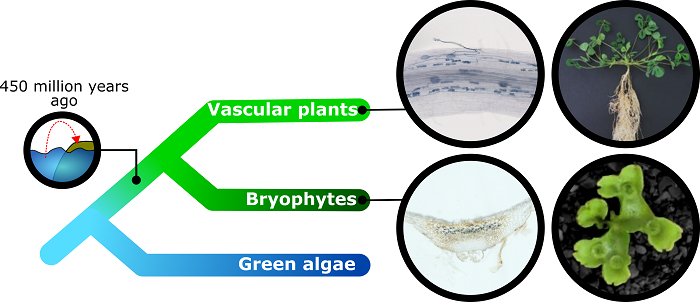To leave the water to live on land about 450 million years ago, plants had to adapt to the terrestrial aridity. In the 1980s, the study of fossils led to the hypothesis that a plant-fungus alliance may have been at the origin of plant vegetation. This has just been confirmed by an international research team led by French scientists lead by the lab of Dr. Pierre-Marc Delaux from the Laboratoire de recherche en sciences végétales RSV (CNRS/Université de Toulouse III - Paul Sabatier) and involving the research group of Prof. Dr. Thomas Ott, Professor for Plant Cell Biology at the University of Freiburg and member of CIBSS. At CIBSS, Ott specialises on the molecular aspects of the symbiotic relationship between plants and other organisms like fungi and bacteria.
To understand life in the past, the researchers had to study present-day plants. These fall into one of two main categories: vascular plants with stems and roots, and non-vascular plants such as mosses, called bryophytes.
Most plants live in symbiosis with fungi, whereby the two organisms exchange resources in a mutually beneficial way. Previous studies have shown the existence of genes that are essential for the proper functioning of this symbiosis, particularly in vascular plants. Here, scientists focused on a bryophyte resembling a succulent plant (see image), for which such genes had not yet been studied: Marchantia paleacea.
By studying M. paleacea, they were able to demonstrate a lipid transfer between the plant and the fungus similar to that observed in vascular plants. By adapting the use of CRISPR, a molecular tool that allows DNA to be cleaved precisely, they were then able to modify a gene predicted as "symbiotic". As in vascular plants, the interruption of lipid exchange between the plant and the fungus leads to symbiosis failure in the bryophyte. The common ancestor of these two groups of plants, which colonised dry land, must therefore have exchanged lipids with the fungus, as do the plants of today. Thus, 450 million years later, one of the secrets of life's first steps on land has finally been elucidated
Numerous international collaborators contributed to this study, including in France, Teams from the Laboratoire de recherche en sciences végétales RSV (CNRS/Université de Toulouse III - Paul Sabatier); the Agrobiosciences, Interactions and Biodiversity Research Federation (CNRS/Toulouse INP/Université de Toulouse III - Paul Sabatier/INRAE), the Laboratory of Plant-Microbe Interactions (LIPM) (CNRS/INRAE), and the Institute of Cardiovascular and Metabolic Diseases (Inserm/Université de Toulouse III - Paul Sabatier).
In Germany the CEPLAS Cluster of Excellence on Plant Sciences at the University of Cologne and of Düsseldorf and the CIBSS - Centre for Integrative Biological Signalling Studies at the University of Freiburg in Germany were involved. Te University of Cambridge in the UK, the University of Zurich in Switzerland, and the University of Tohoku in Japan also contributed to the study.






